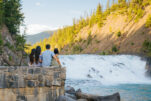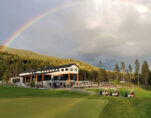Praxis: Learn how to make your own water filter
By Medicine Hat News on May 26, 2018.
It may be hard for us to believe, but there are many people around the world who don’t have clean water to use or even drink. As I may have mentioned before, water is an amazing substance; it’s amazing at deceiving us as well. Did you know that water may look clean, but it may not be safe to drink? We have to be careful what we drink as there may be harmful bacteria lurking about. We cannot see these tricky little organisms with our eyes, only microscopes and trust me; you do not want to get sick from contaminated water. This week, I thought I would show you a simple way to filter out some dirty water you make yourself so you can see that there are ways to clean your water if you ever need to. Let’s get started! *Remember to ask an adult before doing this experiment. Materials – dirt – water – measuring cup – measuring spoon – alum – scissors – rubber band – piece of cheesecloth or spare cloth – clean washed gravel – clean washed sand – 2 L soda bottle – clear glass bowl Procedure 1. Measure 125 mL (1/4 cup) dirt and place it in the bowl. 2. Stir it up really well with your hands. 3. Observe how dirty it looks. 4. Add 5 mL (1 teaspoon) of alum to the water and stir it up. Observe. What do you see? 5. Set it aside for now. 6. Have an adult help you cut the 2 L soda bottle about three quarters of the way up. You will now have two pieces. 7. On the piece with the neck of the bottle, put the piece of cloth over the mouth of the soda bottle (where you would pour the soda out of). This piece of cloth will prevent anything from falling out. 8. Secure it in place with a rubber band. 9. Place this piece into the larger piece neck facing down. 10. Fill this upside down piece about 1/4 full of gravel 11. Repeat with sand. 12. Pour the dirty water you made over your filter. 13. Watch as the water passes through all of the filters (sand and gravel) and slowly drips out the end of the bottle in to the bottom. 14. Observe the filtered water. 15. Try using different amounts of sand and gravel to see if it makes a difference in how clear the water looks. Note: Do not drink this water as you cannot guarantee how clean it is. What is going on? You may have observed that there were still tiny pieces of dirt floating around in the water. Well, how do we get rid of these? In this experiment you added alum (which you can get at most grocery stores) which was very important in the process of forming colloids. The alum allows these colloids to stick together forming clumps or flocs. Eventually these large clumps will become so heavy they will sink to the bottom in a process called flocculation. As this process occurs, it gathers up all of this dirt at the bottom of the container. Once it is all together in one big clump it can be removed much easier from the water. The sand and gravel layers you used were a filter that trapped anything that may not have sunk to the bottom, allowing for even cleaner water to emerge. Water is essential for all life. As I mentioned, not all of the water we see or have access to may be safe to drink. Even when water looks clear, there may be microorganisms that need to be removed from it before we drink it. What you did in this experiment is similar to what a water treatment facility in your town or city may do before you drink the water, only they do it on a much larger scale! They filter the water through a variety of steps to remove the debris and dirt out; they may even add chlorine or use an ultraviolet light to make sure all of the harmful microorganisms are not in there any longer. Note to all teachers that this may be a great activity to do with your class for World Environment Day on June 5! If you need more details give us a call at Praxis as we would love to help you out. Patty Rooks is senior scientific consultant at PRAXIS, “Connecting Science To The Community.” Contact Praxis at praxis@praxismh.ca, http://www.praxismh.ca, Tweet or follow us @PraxisMedHat, or friend us on Facebook. 38-37




